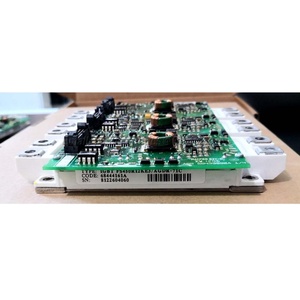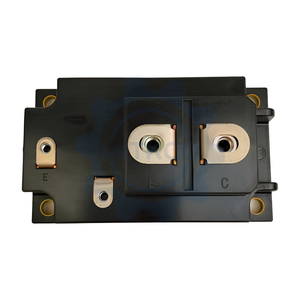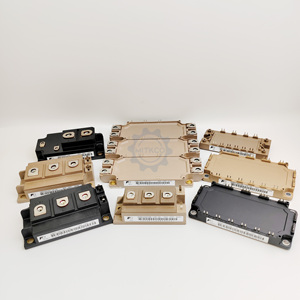
All categories
Featured selections
Trade Assurance
Buyer Central
Help Center
Get the app
Become a supplier

(2162 products available)





























An insulated gate bipolar transistor (IGBT) module AC controller is a variable frequency drive, crucial to the efficient control of motor speeds. It combines the high-speed switching of a MOSFET with the saturation voltage of a bipolar transistor.
Here are some of the IGBT AC Controller modules:
This module involves a single IGBT in one housing or package. This serves as a simplified version of other multi-component structures. The main advantage of the single module is the low cost and compact size for systems with moderate power.
These dual configurations contain both the IGBT and the diode within a single package. There are several differences in types, like the freewheeling or mature diode, critical for bipolar transistor applications.
This involves multiple IGBT chips bundled together in one unit. This is helpful for large-scale or high-demand applications needing extra power. It also improves thermal efficiency by spreading the load over several chips.
These are built for the specific conditions and requirements of railway systems, such as train drives. These modules have high reliability, especially in extreme weather, and can handle high voltage transients often seen in overhead train wire systems.
These configurations have 4 IGBTs forming a half or full bridge circuit. The bridge circuit module provides three-phase control in motor drive applications. This is for industries like manufacturing, aerospace, and transportation.
The durability of IGBT AC controllers has become especially important in harsh operating environments. There have also been demands for more efficient power control solutions. Knowing the materials that make up these modules is a huge factor in their durability and reliability.
As mentioned, heat sinks are crucially important in dissipating the heat generated by IGBT. This keeps the module at an optimal operating temperature. Common materials include aluminum, copper, and sometimes graphite composites. These materials have a combination of thermal conductivity and lightweight properties, which keeps them cool and secure.
IGBT module housings are mainly fabricated from hard plastics. These are either polyamide or epoxy resin-based thermoset plastics. They are resistant to thermal cycling and mechanical stress. This is often observed in industrial conditions. These housings protect the internal components even when exposed to dust, moisture, and other contaminants.
For railway IGBT modules, the casings may be reinforced with glass fibers to enhance structural integrity in extreme weather. This includes exposure to low temperatures, high humidity, and severe vibrations.
IGBT chips are mostly fabricated from silicon. A select few high-efficiency modules use silicon carbide (SiC) or gallium nitride (GaN) for better performance.
Silicon carbide modules have better thermal conductivity and a wider band gap. That means they can operate at higher temperatures and voltages without degrading. This provides greater durability in environments with extreme heat or heavy workload.
On the other hand, gallium nitride is mainly used in fast-switching applications. It is a form of highly efficient IGBT with lower leakage currents. This optimally reduces heat generation and increases longevity.
Many IGBT modules with diode uses silicon or silicon carbide for the diodes. Like the IGBT, silicon diodes are more standard. They provide reliability at an affordable cost.
On the flip side, SiC diodes significantly improve the system's efficiency. They reduce energy losses during the switching. The enhanced durability results in less heat generation and effective back EMF (Electromotive Force) handling.
The global IGBT market was worth about $3 billion as of 2021 and is estimated to grow at a CAGR of approximately 10% until 2026. This growth is due to the increasing needs for energy efficiency and power management in several industrial applications.
The manufacturing industry is one of the biggest users of IGBT modules for motor drives, especially in inductive heating and welding equipment. They control large motors and heavy machinery to ensure stable power supply.
The energy space is all about using IGBT for power conversion and motor control in renewable energy systems like wind turbines and solar inverters. IGBTs help manage large fluctuations in power in what is otherwise a variable and intermittent energy source. They adjust the motor speed for optimal energy capture without damaging the system, thus prolonging the system's life and decreasing maintenance costs.
Railway systems employ IGBT modules to drive electric trains. They are used in smooth, energy-efficient speed control while handling high voltages. These modules are also used in braking systems to provide regenerative braking, which helps energy conservation and reduces wear on mechanical brakes.
Aeroplanes have IGBT modules for environmental control, like air conditioning systems and fuel pumps. The modules provide reliable power control even in the harshest flying conditions. The smooth operation and reliability ensure no system failure, which is crucial for safety in the air. Besides, the IGBT modules are lightweight, helping conserve fuel and improving energy efficiency.
The IGBT modules help control large air conditioning units in commercial buildings. It does this by regulating compressor speeds in tune with the building occupancy and weather conditions. This optimally reduces energy consumption without sacrificing comfort.
In VFD applications, the IGBT modules provide efficient motor control for industrial motors, pumps, and drives. They offer precise speed and torque control by adjusting the output voltage and current. This improves process efficiency in industries like manufacturing, oil and gas, and chemical processing.
There are several factors to consider when selecting an insulated gate bipolar transistor (IGBT) module AC controller. Here are some:
Check if the IGBT module can operate at the temperature conditions in its setting. The heat sink design should ensure proper thermal management to maintain optimal IGBT operating conditions and prevent overheating. Also, consider temperature ranges, as high temperatures can affect module performance and drastically reduce its lifespan.
As discussed, there are two main power supply systems. The CC system is for loads that can easily fluctuate. These loads are mainly resistive or can be found in metalwork applications. Conversely, the Pulse system is for electromagnetic machines like relays and solenoids. Understanding the IGBT module's load type helps determine the module's proper switching behaviour and efficiency.
Different applications require different pulse widths for standard PWM (Pulse Width Modulation) techniques. The PWM is ideal for power supplies and motor control. The IGBT module has to be selected based on the specific modulation technique of the application to avoid large voltage ripples.
Ensure the IGBT module can handle the maximum voltage and current of the application without going overboard. Too much stress on the module can cause overheating and failure, while insufficient ratings lead to poor performance. The ratings also have to be aligned with the system requirements to ensure the module can support the required load with the desired output.
Higher switching frequencies lead to better control and smaller filter sizes. Conversely, lower frequencies provide better efficiency under certain industrial loads. A switching frequency has to be considered based on the application's needs. Also, ensure that the IGBT module is rated for the switching frequency to prevent overheating from excessive power losses.
IGBT modules with built-in protection features, like overcurrent, overvoltage, and thermal protection, will ensure long-term reliability and prevent failures that may arise from an excessive operating condition. These features are crucial in continuous-duty applications like industrial machinery, energy systems, and transportation.
The main aim of the IGBT module AC controllers is to control electric motor speed and power in various industries, ranging from manufacturing and transportation to renewable energy. These modules help convert and regulate power to ensure efficiency and reliability.
These controllers are mainly used in the transportation and energy sectors of the industrial space. They are also used in the mechanical and commercial HVAC systems. Basically, they are used anywhere the control of electric motors and power management is needed.
IGBT modules have heat sinks that help dissipate heat to prevent overheating during operation. This maintains optimal operating conditions for the module. The IGBT modules also have different types of heat sink materials with varying degrees of thermal efficiency and strength. They can withstand extreme environmental conditions.
The IGBT modules help reduce energy losses during power conversion and motor operation. They provide precise control over motor speed and torque. This leads to reduced power consumption, especially in dynamic applications like electric vehicles and HVAC systems.
Like railway housings, many IGBT modules are designed to withstand harsh environmental conditions. They are fabricated from durable materials resistant to moisture, dust, and extreme temperatures. This maintains performance and reliability, even in adverse conditions.